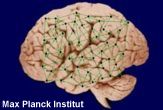Brains May 'Jump' for Diversity

Each of us has a unique head on our shoulders.? Although the basic hardwiring of the brain is the same, there are variances in shape and organization that make even the brains of identical twins look different.?
How much of this is due to environmental factors or genetic pre-programming has never been fully worked out.
But scientists have now found a connection between the variety in the brain's neurons and certain genes that can change their position in the genetic code.? These so-called "jumping genes" may gently scramble the blueprints for the brain.?
"This mobility adds an element of variety and flexibility to neurons in a real Darwinian sense of randomness and selection," said Fred Gage from the Salk Institute.
Jumping genes, also called transposons or mobile elements, are found in all living things.? Approximately 20 percent of the genetic code in mammals is of the jumping variety.? But only a small fraction of these are "active" - which means they are able to successfully reinsert themselves into a new spot in the code.
The fact that jumping is not easy to do is probably a good thing.
"You wouldn't want that added element of individuality in your heart," Gage said.
Sign up for the Live Science daily newsletter now
Get the world’s most fascinating discoveries delivered straight to your inbox.
But active jumping genes have been observed in sperm and egg cells - possibly providing a small kick to evolution by instilling tiny alterations to the genetic make-up of the next generation.
Gage and his colleagues tested a specific class of human jumping gene - called long interspersed nuclear element-1, or L1 for short - in cultured rat brain cells and genetically modified mice.? The experiments are detailed in this week's issue of Nature.
What the scientists found is that L1 elements made hops in neuronal precursor cells (NPCs), which are cells that are destined to become neurons.?? This is the first time these jumps had been observed in cells other than sperm and egg cells.?
NPCs can turn into a variety of different neuron types - pyramidal and basket cells, to name just two.? If an L1 lands in the middle of an NPC gene associated with neural function, it could affect which type of neuron the NPC eventually becomes.?
"What may happen is that when you are making a brain, there is a scattering of variability due to random shuffling by these jumping genes," Gage told LiveScience.
But exactly how much of this shuffling goes on in human brains has yet to be studied.??
In a separate commentary, Eric Ostertag and Haig Kazazian from the University of Pennsylvania point out that if jumping is entirely random, the L1 elements may rarely land inside a relevant gene.? There is some evidence, however, that the jumping genes actually target places in the code where they can make a difference.?
Evolutionarily speaking, one might wonder how this remarkable hopping came into existence.? In most cases, a genetic mutation that provides a survival advantage eventually becomes incorporated in a population.? But these gene-altering jumps only affect how one brain develops and cannot be passed on to the next generation.?
A possible answer to this Darwinian riddle is that there could be a definite advantage to a population in having programmed variability in the thinking caps of its members.
"If diversity was important, then the mechanism for creating diversity could be passed on," Kazazian said.
Related Stories
X Chromosome Key to Differences in Men and Women
Group Releases Mouse Brain Genome Data
Scientists Turn Stem Cells Into Neurons











